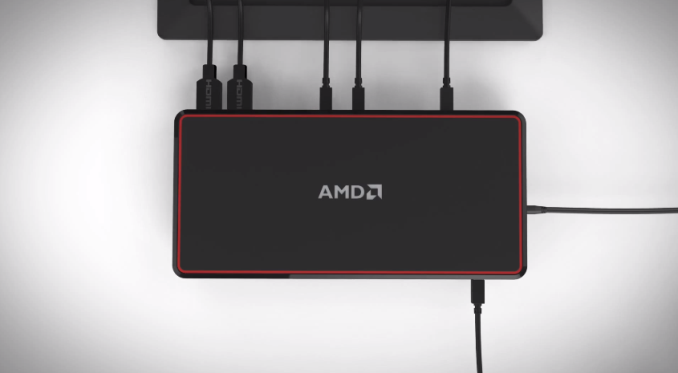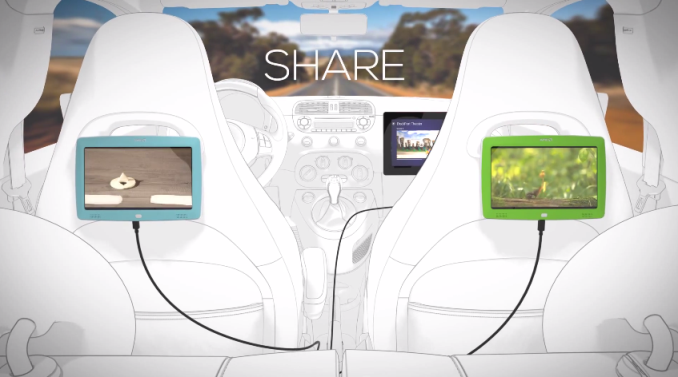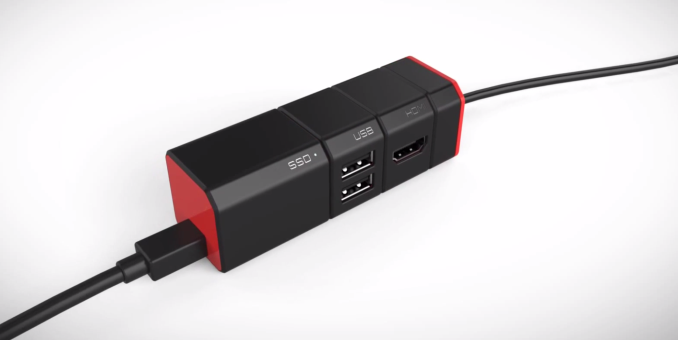AMD’s DockPort Given Virtual Overview
by Ian Cutress on February 13, 2014 4:58 AM EST- Posted in
- AMD
- DisplayPort
- DockPort

Flying somewhat under the radar, DockPort from AMD is designed to be a low-cost all-in-one solution for external connectivity for a PC or tablet. Sound familiar? Like Thunderbolt familiar? This is AMD’s solution to the issue of connectivity, using the DisplayPort connector to transfer USB information as well as audio/visual.
Not a lot has been said about DockPort, despite originally being given a name sometime in 2012, but since CES 2014 has been adopted as an official DisplayPort standard extension by VESA with a finalized standard expected in Q2. With the combination of DisplayPort and USB 3.0 over a single cable, AMD’s video explains it best how it can be used:
To list the possible uses:
- Charging (over USB 3.0 standard we would assume)
- Docking to an external keyboard/battery/audio
- Connecting Storage, Audio outputs, Video outputs, USB hubs
- Share video or run multiple video screens
Basically this is everything USB can do, including video stream via DisplayPort, albeit in a single interface that is already standard across many systems and form factors. AMD have not specified what extra hardware is needed beyond DisplayPort compatibility (presumably the next iteration of the DisplayPort standard) or whether this extension is just for limited use with a bridge chip. DockPort verified cables will be needed, and no idea on the cost of those this early in the development cycle, or whether the standard will be roped into DisplayPort fundamentally. The main competition is of course with Intel's Thunderbolt, where one of the features I am most looking forward to is Graphics over TB. That will not be possible with DockPort, but it will try to do everything else it seems, although it does seem to suggest that DockPort will be limited to USB 3.0 for any data-related daisy chaining, unless AMD have an ace up their sleeve.
I would imagine AMD would tie this technology into their desktop motherboard line, as well as their SoCs, when it is ready which might increase adoption rates faster than Thunderbolt. Having both interfaces use a similar sort of connector asks the question whether the two interfaces might be coherent in the same output/input, making future devices (namely storage) able to use both in one connector rather than have specific DockPort/TB inputs.
This is still early days, given the computer generated nature of AMD’s video. Computex is still several months away – we might see an real world update then. Looking forward to it…!


















52 Comments
View All Comments
shank15217 - Friday, February 14, 2014 - link
What compromises?repoman27 - Saturday, February 15, 2014 - link
The biggest one is that using SuperSpeed USB reduces the DisplayPort main link to 2 lanes. Unless you're connecting a display with a DP 1.2 sink on board (which are rather uncommon at this point), that would limit you to 1920x1200 resolutions at 60 Hz, 24 bpp. If you want to use MST to drive more than a single display, you have to press a button which disables SuperSpeed USB and relegates you to a single shared USB 2.0 port for all connected devices.Also the use of DP_PWR means that all DockPort devices need to have tethered cables per the VESA specification.
Honestly, for the intended market, these are completely reasonable trade-offs though.
AnnonymousCoward - Monday, February 17, 2014 - link
That's a good point.....I guess you can't do dual-1080p if monitors only support 2.7Gbps DP1.1.speculatrix - Thursday, February 13, 2014 - link
a colleague recently bought a cheap Acer laptop which has a combo displayport + usb port, and Acer have adaptors which can give you VGA or HDMI out along with with USB ports and network.I am wondering whether it's in any way similar to the AMD standard, or Acer's proprietary take on the idea.
repoman27 - Thursday, February 13, 2014 - link
Note my reply to SilentSin above. Proprietary name (Mini Converter Port / Mini CP) but same TI DockPort silicon. I believe Acer may have beaten AMD's branding to market though, and now that it's part of the VESA DisplayPort standard, they might decide to drop the Converter Port nomenclature.Wolfpup - Thursday, February 13, 2014 - link
I'm not really getting the point to this...I mean it's just Displayport + USB 3.0 over the same connection? Is there any real need for that? Displayport is barely used, and I can't see this doing much better, all to save having a second cable...and even then not really, since you'll still need regular USB connections somewhere (like on your "Dockport" monitor).I don't know...this seems like a cheaper way to do something similar to Thunderbolt, but like Thunderbolt (and Displayport itself) I don't see this really taking off.
Like others, I still think the idea of easily chaining multiple monitors is cool (if there's no tradeoff), and I still see the idea of being able to attach an external GPU through Thunderbolt as REALLY cool...but we're just not seeing much adoption of any of that. Aside from one system from Sony, no Thunderbolt external GPUs (and what we really want is a dock that works with ANY video card-throw in a Titan or whatever and connect it to your notebook and it works without special drivers).
But none of this is actually happening. There's barely any Displayport monitors, almost everything, notebooks, desktops, and monitors, are using DVI/HDMI and USB 3.0. I just don't see this other stuff as ever taking off, since we've had it for years and it's not taking off.
schizoide - Thursday, February 13, 2014 - link
4k is coming fast. You'll be using displayport if you buy a new monitor in 18 months.SirKnobsworth - Friday, February 14, 2014 - link
What DockPort offers is convenience. Plenty of people bring their laptops around with them, but want a bigger display when they're at home. So rather than coming home and plugging in power, the display, and let's say a USB keyboard and some speakers, you plug in one DockPort cable which handles all that.You're probably right that it's probably not going to appear in many displays. What it will appear in is docking stations for laptops which provide a display output, USB ports, audio, power and maybe a NIC.
piroroadkill - Friday, February 14, 2014 - link
You missed power. This cable provides enough power to run the laptop. That's kind of the point.CSMR - Friday, February 14, 2014 - link
What we need is a standardized dock. This is close but not there.Charging (45W or more), multiple USB connections, displayport, ethernet: I.e. standard laptop connections.
There is no need to fit everything into a displayport cable. I do not believe that all the above can be pushed into an existing displayport cable without compromise.
Pushing it into an existing displayport connector creates confusion, when people plug this into monitors directly instead of into a dock, or plug a regular displayport output into a dock.